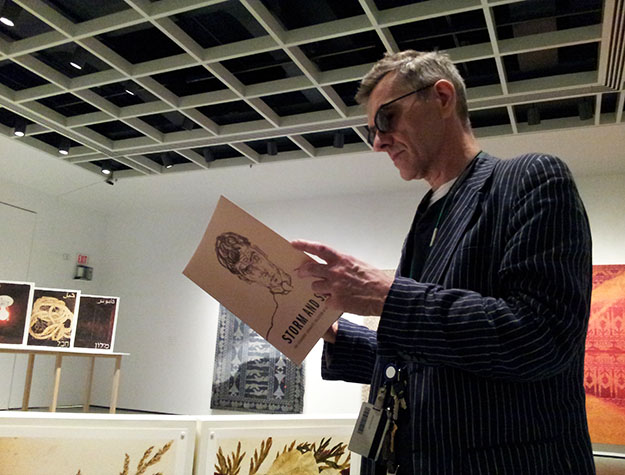Uncovering ‘darker things’ in McMaster’s German expressionism collection

McMaster Museum of Art senior curator Ihor Holubizky reviews an essay he contributed to the 'Storm and Spirit' exhibition catalogue. He'll deliver a lecture at the Winnipeg Art Gallery on Nov. 15, focusing on McMaster's extensive German expressionism collection.
More than a dozen works from McMaster’s extensive German expressionism collection are currently on loan to the Winnipeg Art Gallery for an exhibition entitled, Storm and Spirit: The Eckhardt-Gramatté Collection of German Expressionist Art.
The showcase pays tribute to 25 influential artists from the early-mid 20th century, and features landmark pieces culled from the the McMaster Museum of Art, the WAG and the National Gallery of Canada.
On Friday, Nov. 15, McMaster senior curator Ihor Holubizky will deliver a talk at the WAG focusing on the roots and lasting influence of the European expressionist movement. The paintings and woodcuts on display in Storm and Spirit are bolstered by a selection of graphic work from McMaster’s collection, including pieces by Max Beckmann, Otto Dix, Vasily Kandinsky and Ernst Ludwig Kirchner.
“Expressionism is a tricky word to define, because it’s not just about aesthetics,” said Holubizky, an expert in 20th century avant garde art who joined the University in 2009. “The German movement wasn’t so focused on advancing the craft of painting. It was more about delving into darker things. It was the artists’ response to something that is unthinkable.”
The University’s collection of related works, particularly those from Germany, is considered one of the most important and extensive in the world.
“McMaster has a very good reputation in this area. It is, along with the Montreal Museum of Fine Arts and the Art Gallery of Ontario, without a doubt the country’s finest,” said Andrew Kear, curator of Historical Canadian Art at the WAG.
A bold and visually arresting movement, expressionism rose to prominence in Europe during the early-mid 20th century; a bleak 30-year period that saw the continent ravaged by two World Wars, the rise of fascism and the Holocaust. During this time, many of Germany’s premier artists began turning their attention toward stark, austere themes and imagery; drawing inspiration from their surroundings and incorporating the bold use of positive and negative space found in traditional German woodcut prints.
Influential artists such as Käthe Kollwitz, Ernst Kirchner, Otto Dix and George Grosz (all represented in McMaster’s permanent collection) were the driving forces behind the German movement during the Weimar period between World Wars. Contemporaries included the likes of Edvard Munch, Vassily Kandinsky, Georges Rouault and dozens of other painters and sculptors from around the world.
“There is often brutal honesty in their work in response to the devastation of war, hypocrisy of the establishment and social injustice,” explained Kear. “I think people respect this, understand the professional risks these artists faced in presenting such unadorned vision of reality. German expressionism isn’t all bleak storm and stress, though. There was a great optimism among expressionists before the First World War that manifested in a celebration of the hustle of cosmopolitan life, the awkward beauty of everyday people as well as nudity and sexual liberation.”
The infamous Degenerate Art Exhibition of 1937 is considered by many historians to be the high water mark of the German expressionist movement; an ironic twist, given that the show was curated by the Nazi Party to shame and denounce “incompetents, cheats and madmen” in modern art. More than 100 artists were represented in the exhibition, including many from Germany.
McMaster’s push to assemble a German expressionist collection began during the early-1960s, when a team of academics led by George Wallace, Karl Denner and Naomi Groves began acquiring a number of grossly undervalued German works. At the time, public opinion in Canada, the United States and Britain steered many art collectors away from German art, with the shadow of the Second World War still lingering.
“For a long time, it was deemed ‘unpatriotic’ to acknowledge any kind of German influence in the world of modern art,” explained Holubizky. “But there were a number of academics, at McMaster and beyond, who recognized that Germany has long existed as a centre of intellectual thought and expression. They recognized the value in acquiring these works.”
Over the years, the McMaster collection was expanded thanks to generous donations from a number of patrons, including Herman Levy and Rabbi Bernard Baskin.
Storm and Spirit will be on display at the Winnipeg Art Gallery until Dec. 8.

